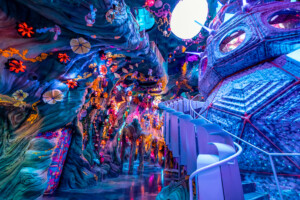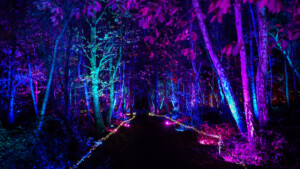A look at how some UK theme parks are managing to both entertain thier guests whilst being "green".
With climate change increasingly at the forefront of public consciousness, the 72% of companies with no green marketing plans in place will be left behind according to research from the GreenPortfolio, the specialist environmental relations division of Portfolio Communications. A survey reveals that 50% of marketing and PR professionals believe that an organization’s green credentials are important to customers; and 84% predict this importance is likely to grow further over the next two years as the impact of environmental issues continues to make itself felt.
by Rachel Read.
The business case for corporate and social responsibility has historically had to look long term and incorporate softer measures, such as employee recruitment and retention (60% of employees cite the importance of environmental credentials), brand differentiation, and risk management in order to justify itself. However, with heightened concern over global warming, customers are now willing to pay more for environmentally friendly products, and companies that can demonstrate green credentials can gain real competitive advantage.
The attractions business is beginning to address the demand for green theming and clear environmental policies, however GreenPortfolio’s research suggests that a surface veneer is not enough when it comes to public perception, and “greenwashing” will not fool the customer. An additional consideration for the attraction operator is the need to balance environmental education aims with entertainment. A closer look at two UK attractions shows that the key is to have a consistent and genuine environmental ethos, permeating the corporate culture, together with an experience where visitors have fun.
Success despite the Wretched British Summer
BeWILDerwood, a 40-acre attraction in Norfolk, UK, which opened in May 2007, has shown that environmental sensitivity can be hugely appealing. BeWILDerwood developers Simon Egan and Tom Blofeld had no previous experience of attraction development or operation, just a 40-acre wetlands parcel and wonderfully vivid memories of their own outdoor play as kids. Over three years they have developed the site into a magical land that fosters the imagination, as children can explore their environment through treehouses, boat rides, mazes, platforms, rope bridges, zip wires and slides. The attraction has enjoyed phenomenal success: in the first 14 weeks BeWILDerwood welcomed 100, 000 visitors (35, 000 more than projected), despite a particularly wretched British summer.
What Egan and Blofeld lack in industry experience they have made up for in enthusiasm, flexibility and creativity. They decided that the problem with mazes was that once you had got to the center it was boring to have to retrace your steps. The solution: to build the maze around a tree with a spiral staircase around its trunk. The adventurer climbs up the staircase out of the maze and then descends via rope bridges and slides.
Half way through the attraction development they recognised that the play elements were not interesting enough by themselves. Egan explained that the plans seemed “too dry and needed fantasy.” They called in Farmer Attraction Development to help with theming by “inhabiting the woods and sprinkling pixie dust”. Steve Pearce, a freelance illustrator brought in by Farmer Attraction Development, came up with four key characters to live in the woods and Blofeld, who “had always wanted to write a book, ” penned a tale of adventure for the characters, taking them through the attraction. (Blofeld obviously had some untapped talent as a children’s author, as 20, 000 copies, one for every five visitors, have been sold to date.)
The creation of their own brand and theming that has captured the imagination of the visitors has made BeWILDerwood into an exciting physical adventure for children of the playstation generation. Egan believes that the fundamental reason for their success is that the attraction is fun, however, there is a subtle but effective environmental message conveyed as well.
Green Ethos should run Deeper than the Theming of the Attractions
BeWILDerwood’s green credentials go beyond obvious eco-theming. The development has been of a sustainable timber construction and the wetland areas, including reed beds, are now being managed appropriately. The boats used for the initial ride from the entrance to through the swamp are recycled lifeboats which have been converted to electric power, and the food offered is organic and locally sourced.
Egan acknowledges that being green can involve a higher cost base, but they have not found that the public have been put off by their pricing structure. Egan likens BeWILDerwood to a deli among supermarkets; people are willing to pay more for their clearly differentiated product.
While there have been a few inevitable initial teething problems, at the end of a whirlwind first season Egan is excited about their success, the level of which has enabled them to employ a dedicated operations manager, bring forward capital projects and, more importantly, to enable Egan and Blofeld to focus on creative development. Egan describes his job as a “joy.”
Existing attractions wanting to go green will find it difficult to rebrand themselves as eco-warriors overnight, but Crealy Great Adventure Parks, established in 1989, demonstrates that a more traditional attraction can also show itself environmentally astute. Based on two sites in South West England, the Crealy properties include typical theme park rides, log flumes, rollercoasters and go-carts alongside eco-themed attractions, including a sunflower maze and pumpkin patch that help sustain the diversity of local wildlife, and educational nature trails. In addition, there is also a Roundabout PlayPump, which teaches visitors about the value of water conservation.
As with BeWILDerwood, Crealy’s green ethos runs deeper than the theming of the attractions. Crealy’s website includes an impressive environmental statement setting out their commitment to corporate and social responsibility through a variety of initiatives, including a tree planting scheme to make the property carbon-neutral, ongoing improvements in recycling, and increased purchasing of local produce. Farringdon Council in East Devon has recognised Crealy as “… a good example of sympathetic development in the countryside.”
Jenni Taffs of Crealy press relations says, “Our guest survey results show that 97% of our guests think it is important that Crealy reduces its carbon footprint. Yes, there are costs to the business, but the reaction from our guests makes it worthwhile. It is essential to our corporate culture in that our staff, customers and community expect it… Crealy’s focus on sustainability of the environment and community is vital to its success.”
This article appeared first in print in the 2008 TEA (Themed Entertainment Association) Annual.











